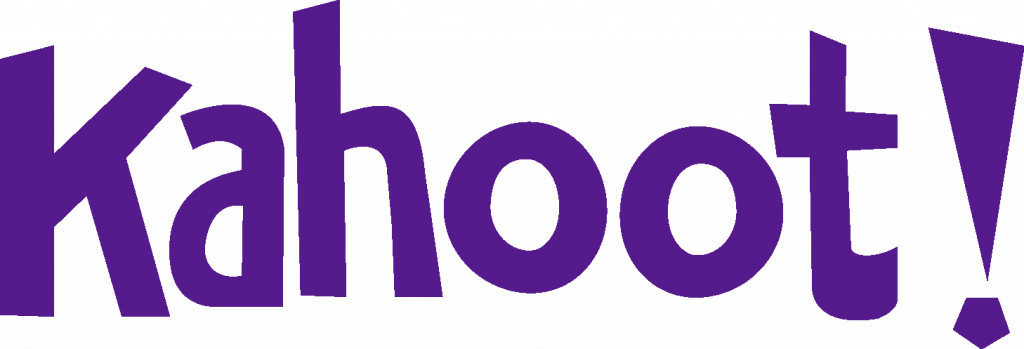Kahoot!
 ™
™
Price: Free to access; paid options available
Summary: A game-based student response system (GSRS) that transforms the classroom into a game show.
Overview
Kahoot is game-based student response system (GSRS) where the classroom is temporarily transformed into a game show (Wang & Tahir, 2020). A game is created by the host -which can be the teacher- using a combination of polls, puzzles and slides.
For the quiz and survey functions, the host can create questions with between two and four possible answers for students to choose from. While creating each question, the host can set a time limit (up to 120 seconds) for the responses (Iona, 2017). The host can also specify which answer(s) are correct, and whether to award points for the question or not when creating a quiz. After creation of the Kahoot, it can be previewed which allows for testing the delivery and functionality of the game.
Afterwards, the game can then be played by the student either collectively in a classroom setting with other students by displaying the activity on a screen, or individually through distance learning. Players can access the game via Kahoot.it from an internet-enabled device such as tablet, mobile phone, or computer. When a Kahoot is launched, it has its own unique, randomly generated PIN which the students will use to join the game (King, 2017).
Each student can choose a nickname or use their own name prior to the start of the game. During the game, the questions and up to four multiple choice answers -each with a distinctive color and shape- are displayed on the screen (King, 2017). Players can earn points for answering questions accurately and quickly. The top-scoring three students will be displayed after each question. The name of the student with the most points will be shown at the end of the game.
Critiques and Implications for Education
Since the release of Kahoot in 2013, there have been many studies published on its use in the classroom. Wang and Tahir’s 2020 literature review investigated the effects that Kahoot has on students’ learning performance, classroom dynamics, motivation, engagement, concentration, and enjoyment, and how teachers perceive the use of the platform compared to other teaching methods.
Benefits
Of the 93 studies that were included in the literature review, there were many positive effects highlighted for the gamified approach compared to the traditional one, including:
- improved class attendance
- fewer late arrivals to class
- higher downloads of course material
- improved classroom dynamics
- higher final grades
These benefits of Kahoot may be due to its surface-level gamification features such as suspenseful music and colour displays which targeted users’ needs for challenge, fantasy, and sensory curiosity (Licorish et. al, 2018).
Additionally, Kahoot offered real time feedback for students, filling the gap between students’ knowledge and what they were expected to know (Youhasan & Raheem, 2019). Therefore, Kahoot could promote learning, problem solving, and render education more enjoyable by encouraging social ties, specialization ability, and ambition to achieve success in a competitive environment,
Furthermore, Wang & Tahir (2020) noted the implementation of Kahoot as a teaching tool. Of the thirty-six studies which looked at learning outcomes, it was found that Kahoot was suited for K-12 and university settings. Its utilization spanned various fields and courses including language (English and Chinese), Information Technology, Bio-Engineering, Media and Communication, Electric Circuits, Business, Math, Physics, Chemistry, Animal Science, Academic Writing, Educational Technology, Nursing, Vocational Training, Programming, Control Systems, and Earth Science.
Bryant et. al (2018) examined the use of Kahoot with a group of 32 second-semester Nursing students who were learning pharmacology. Students were initially assigned to complete interactive learning tutorials for five medications. They were then given an hour to develop one NCLEX-style multiple choice question addressing nursing knowledge for each of the five assigned medications. (NCLEX stands for National Council Licensure Examination which refers to the nursing licensing exam.) Students were asked to submit their questions with highlighted correct answers to the instructors who reviewed the quality of each question. Ten of these submissions were used then in a Kahoot game where students were given 15 minutes to answer each question. Students reported that generating questions was helpful for learning about medications and also enjoyed using Kahoot as a learning platform. An area of opportunity was the character limit imposed by Kahoot, so the student-generated questions needed to be edited prior to submission to the program template. This study showcased an opportunity for students to be active both in the creation and the completion of a Kahoot activity.
Additionally, Wang & Tahir (2020) highlighted that no studies in their literature review reported Kahoot as having negative or neutral effect on classroom dynamics. With respect to student anxiety, only two of the studies tested for statistical significance, and found that playing Kahoot in class reduced anxiety. The lack of anxiety may be related to the concept of anonymity offered by Kahoot, which allowed students to feel safer when responding to questions (Licorish et. al, 2018). Students had the option to choose a nickname or use their own at the start of the game, and the nickname option was favoured by students who preferred a less competitive environment (King, 2017). This also allowed students to focus on comparing the content of Kahoot and differences of opinion, rather than students’ aptitudes (Licorish et. al, 2018).
Challenges
While there were reports of increased student motivation, confidence, enjoyment in the classroom, learning experience and efficiency, the use of Kahoot did present some challenges (Wang & Tahir, 2020). These included:
- Technical problems such as unreliable internet connections and hard-to-read questions and answers on the projected screen
- Not being able to change answers after submission
- Stress due to time pressure
- Not having enough time to answer
- Fear of losing
- Having difficulty catching up after submitting an incorrect answer
Access and Cost
Signing up for Kahoot is free, and gives users access to the basic tools needed to create, play and host games in a classroom setting. There are progressively more expensive plans which unlock more question types, the ability to collaborate with colleagues, and access other tools such as interactive lessons and reports. There is pricing for Kahoot for higher education which allows for hosting games for more players from 100 up to 2000 players as well as more customization to music, images and question types.
About the Author

Hoi Man Leung
Hoi Man Leung is a dedicated health care professional with a demonstrated history of working in hospital, long term care and community settings. She has over a decade of experience in case management, team development along with a passion for patient care.
Her love of sharing knowledge and stories has steered her towards mentoring and educating the next generation of allied healthcare providers. Most recently while working as a front-line worker and studying for her MEd during the COVID-19 pandemic, she has developed a deeper appreciation to pivot and embrace the use of technology.
References
Bryant, S., Correll, J., & Clarke, B. (2018). Fun With Pharmacology: Winning Students Over With Kahoot! Game-Based Learning. The Journal of Nursing Education, 57(5), 320–320. https://doi.org/10.3928/01484834-20180420-15
Iona, J. (2017). Kahoot. School Librarian, 65(2), 84–.
Kahoot! (2018, September 27). What is Kahoot!? [Video file]. YouTube. https://youtu.be/7XzfWHdDS9Q
King, A. (2017). Using Kahoot. Australian Mathematics Teacher, 73(4), 35–36.
Licorish, O. (2018). Students’ perception of Kahoot!’s influence on teaching and learning. Research and Practice in Technology Enhanced Learning, 13(1), 1–23. https://doi.org/10.1186/s41039-018-0078-8
Wang, A., & Tahir, R. (2020). The effect of using Kahoot! for learning – A literature review. Computers and Education, 149, 103818–. https://doi.org/10.1016/j.compedu.2020.103818
Youhasan, P., & Raheem, S. (2019). Technology Enabled Formative Assessment in Medical Education: A Pilot Study through Kahoot. Education in Medicine Journal, 11(3), 23–29. https://doi.org/10.21315/eimj2019.11.3.3

